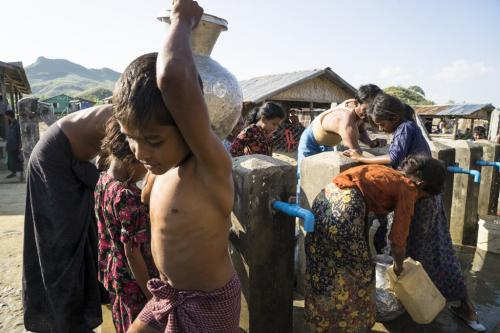Rohingya children trapped in 'appalling' conditions in Myanmar's Rakhine state – UNICEF
While the eyes of the world are on Myanmar's northern Rakhine and Cox's Bazaar, Bangladesh, more than 60,000 Rohingya children remain nearly forgotten, trapped in appalling camps in central Rakhine where the shelters teeter on stilts above garbage and excrement, the United Nations Children's Fund (UNICEF) reported Tuesday.

Children collect clean and safe water from a tap stand in Kyein Ni Pyin camp, home to almost 6,000 Rohingya displaced by violence in Myanmar’s Rakhine state in 2012.
“Partners have identified about 20 children separated from their families during the violence but estimate the total number to be at least 100 – most of whom are in parts of northern Rakhine state that they still cannot access,” Marixie Mercado, UNICEF spokesperson told journalists in Geneva on Jan 08 during a briefing on her visit to Myanmar from 6 December 2017 through 3 January.
She painted a harrowing picture of the situation in Rakhine, noting that prior to 25 August, when the most recent outbreak of violence occurred, UNICEF had been treating 4,800 children suffering from severe acute malnutrition; these children are no longer receiving this life-saving treatment.
“All 12 of the outpatient therapeutic treatment centres run by our partners are closed because they were either looted, destroyed or staff can't access them,” she underscored.
Ms. Mercado called the inability of UN agencies to access vulnerable Rohingya children who remain in northern Myanmar “troubling,” saying that while “the eyes of the world” are focused on the 655,000 refugees who have fled across the border into Bangladesh, 60,000 Rohingya children remain “almost forgotten,” trapped in squalid camps in central Rakhine.
“The Rohingya children who do remain in rural areas are almost totally isolated. We hear of high levels of toxic fear in children from both Rohingya and Rakhine communities,” she said.
She stressed that UNICEF stood ready to work with the Myanmar Government and Rakhine state authorities to provide humanitarian relief to all children – regardless of ethnicity, religion, or status – but needed unlimited access.
The spokesperson described two of the worst camps that she visited, in Pauktaw Township – reachable only by a four-to-five-hour boat ride.
“The first thing you notice when you reach the camps is the stomach-churning stench. Parts of the camps are literally cesspools. Shelters teeter on stilts above garbage and excrement,” she recounted. “Children walk barefoot through the muck. One camp manager reported four deaths among children ages 3-10 within the first 18 days of December.”
Ms. Mercado also pointed to “an acute level of fear between the Rakhine and Rohingya communities,” recalling a story that parents in one Rohingya village said they hadn't had their children vaccinated against Japanese Encephalitis because the government vaccinators were accompanied by security officers – while Government workers said they dared not go to Rohingya communities without security.
“Rohingya children need a political solution to the issue of legal identity and citizenship. In the interim they need to be recognized first and foremost as children, she said, stressing that the Convention on the Rights of the Child guarantees rights to health, education and opportunities to learn and grow to all children, irrespective of their ethnicity or status or the circumstances in which they find themselves.
Ms. Mercado said that the Annan Commission [a report led by the former UN Secretary-General on the situation in Rakhine state]has provided a roadmap for a durable political solution so all children's rights can be protected in a sustainable, open and fair manner in the longer term.
“UNICEF stands ready to support this crucial work. And we call on the global community, especially regional organizations and countries, to leverage their influence so children have better lives today and a future they can look forward to,” she said.
Source:United Nations
- 254 reads
Human Rights
Ringing FOWPAL’s Peace Bell for the World:Nobel Peace Prize Laureates’ Visions and Actions

Protecting the World’s Cultural Diversity for a Sustainable Future

The Peace Bell Resonates at the 27th Eurasian Economic Summit

Declaration of World Day of the Power of Hope Endorsed by People in 158 Nations

Puppet Show I International Friendship Day 2020

